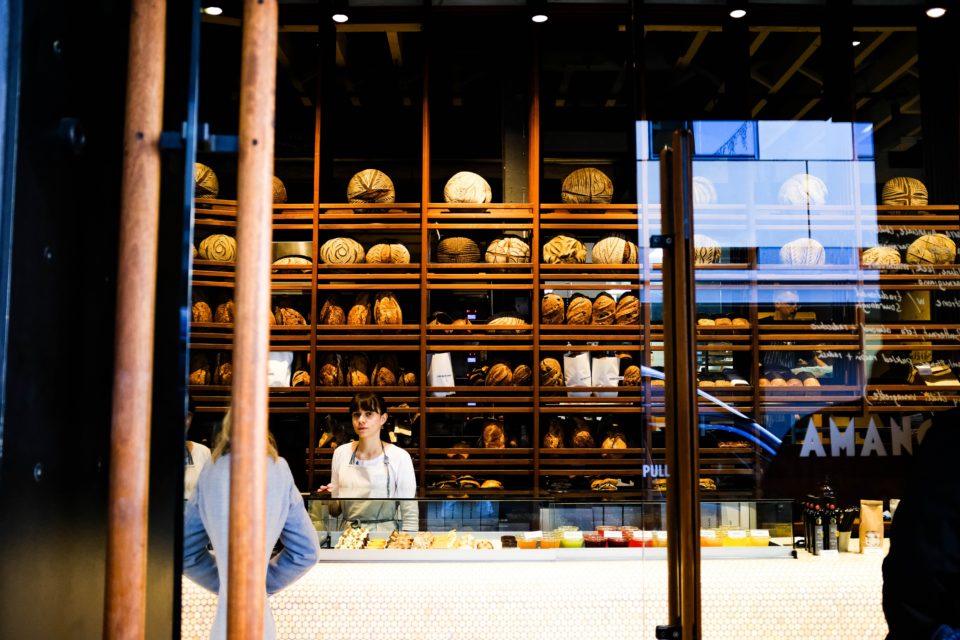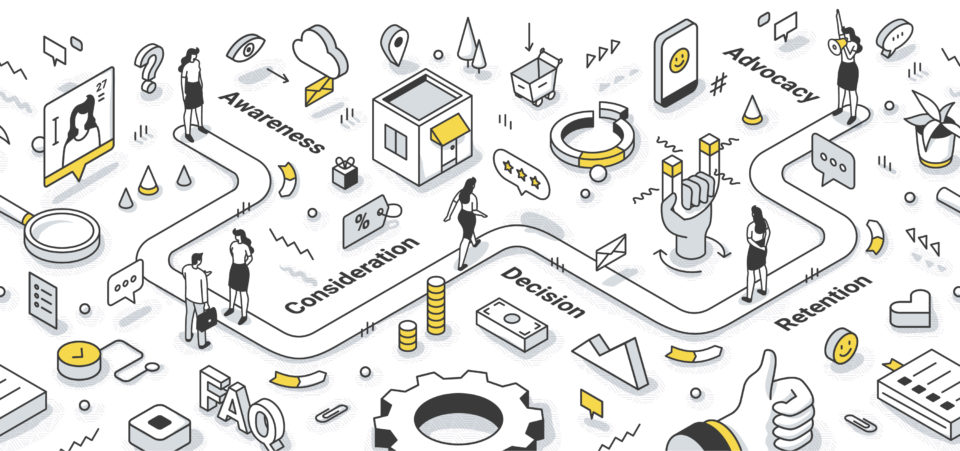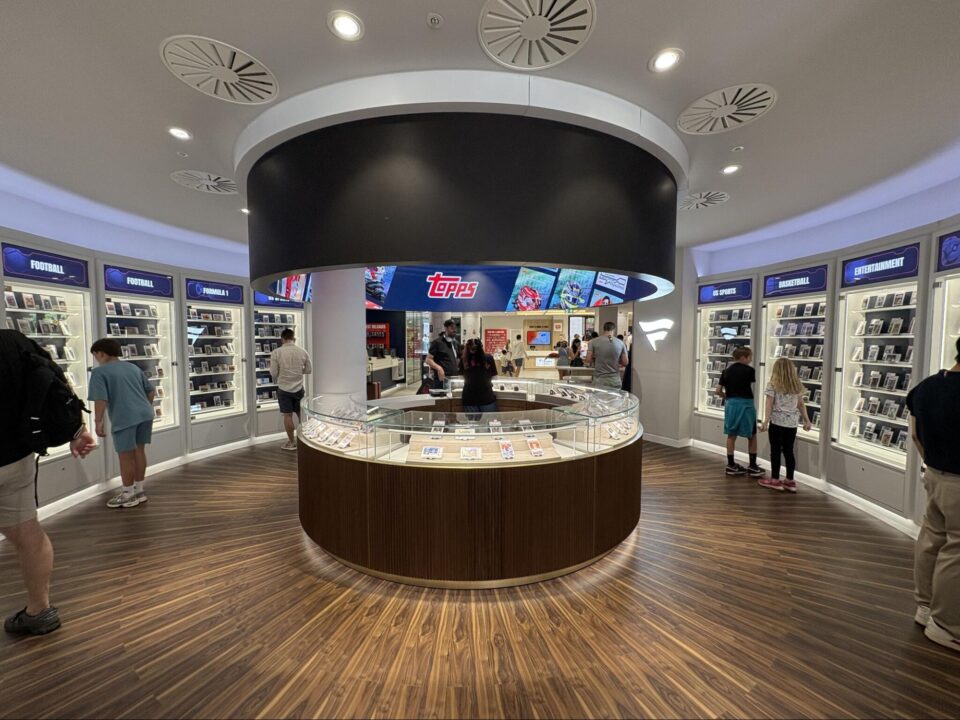The Ultimate Guide to Retail Customer Experience in 2022

If you say that customer experience is important, everyone nods their head. But if you ask why it’s important, the responses are less universal.
That’s a problem because it makes it easy for retailers to misunderstand what customer experience is. It becomes thought of as the icing on the cake, something that is added on top of your business.
In reality, customer experience should be at the centre of every retail business.
It’s not yet though.
A massive 65% of shoppers in the US and Canada feel companies need to improve their overall customer experience. That’s according to the fourth annual Customer Experience and Communications Insights survey from Broadridge Financial Solutions Inc.
However, the good news is that 77% will spend more with a company that provides a good customer experience.
This means that if your retail business can deliver a remarkable customer experience you’ll not only attract more customers, but also increase the customer lifetime value.
In this post, we will explain exactly what customer experience is, why it should be at the heart of your business, and the specific steps to take to create a futureproof customer experience strategy.
Contents:
- What is Customer Experience?
- Why is Customer Experience/CX Important in Your Retail Business?
- How to Measure, Analyse and Manage Customer Experience
- How to Create a Strategy for Great Customer Experience
- Is Your Customer Experience the Best it Can Be?
What is Customer Experience?
Customer experience, or CX, refers to the interactions customers have with your brand and how they feel as a result. It is the customer’s view of your brand.
The customer experience shapes the overall perception of your brand and how satisfied customers are in all their interactions with you. This includes the store, website, social media, app, in-person events and other channels.
The online customer experience focuses specifically on your digital channels and how the customer finds using them.
A customer’s impression of a brand – the customer’s experience – has a significant influence on who they choose to shop and spend time with.
As such, every retailer should be focused on improving their customer experience.
What is the Difference Between Customer Experience and Customer Service?
Is customer experience the same as customer service?
No, but the two are related.
As explained above, customer experience is the view a customer has of your brand as a result of all their interactions with you.
This can be good or bad as you’ll see in a moment.
Customer service refers to the support that a company provides to its customers before, during or after they buy something.
That purchase might be a physical product, but it could also be a digital item or even a service.
Customer service plays a role in the customer experience because it affects the perception a customer has of a company. If they receive poor customer service, it will reflect negatively on the brand. If they receive good customer service, it will reflect positively.
As such, you should always be looking for ways to improve your customer service, such as:
- Clearly signposting ways of receiving support in all your communication and buying channels
○ For example, including contact forms, chat bots, direct message capabilities, email addresses, phone numbers that customers can easily find and use.
- Making sure you follow up with all customer complaints and comments
- Minimising wait times for support
- Letting a customer look up what products are in stock and where online before they visit a store
- Providing as much information as possible to help customers make the right buying decisions such as videos, photos, live streams, reviews
- Focusing on the user experience and making it easy to find what they’re looking for on your website
Now the difference between customer service and customer experience is clear, the question is why is CX important?
Why is Customer Experience/CX Important in Your Retail Business?
How much does customer experience really matter though?
Does it really make a difference to your bottom line?
The answer is yes.
- 56% of UK consumers would be put off buying again from a brand due to a bad experience. (OpenText)
- 73% of UK shoppers have left retail stores feeling frustrated about their experience. (Vococo)
- 86% of US and UK customers will leave a brand they were once loyal to after only two or three bad customer service experiences. (Emplifi)
- In the last 12 months, 49% of customers have left a brand they were previously loyal to due to poor customer service. (Emplifi)
- 43% of US and UK shoppers consider previous good customer experience when making a new purchase. (Emplifi)
In fact, customer experience has more of an impact on the success of your business than anything else.

Shoppers benchmark your customer experience against other brands. They consider their past experiences with your brand when deciding who to buy from. And if they aren’t happy with the results, they take their business elsewhere, cutting into your bottom line.
By focusing on great customer experience, you can:
- Increase customer satisfaction
- Build customer loyalty
- Increase sales
- Increase recommendations
- Reduce customer complaints
- Reduce returns
- Improve your brand reputation
- Increase lifetime value of customers
Retailers do understand this.
Paragon DCX found that 86% of companies agree customer experience directly equates to commercial value. Gartner also reports that 86% of professionals engaged in or leading CX expect to compete based on customer experience.
However, many retailers struggle to actually offer a good customer experience.
Treasure Data/MarTech Alliance reported that 48% of CMOs believe the customer experience their brand offers is not up to the standard consumers expect.
They would be right to think so.
In its 2022 CX and Communications Insights report, Broadridge Financial Solutions found that the percentage of consumers who feel companies need to improve their overall customer experience jumped to 65% from 35% the previous year.
So how do you improve your customer experience?
First, you need to understand the difference between a good and a bad customer experience.
What is a Bad Customer Experience?
A bad customer experience is when shoppers have a negative perception of your brand after interacting with you. They are left feeling unsatisfied by the experience, as well as potentially frustrated or angry.
Things that make for a bad customer experience include:
- Queues and long wait times
- Rude or unhelpful staff
- Missing or wrong products
- Not enough information or misinformation about a product (including sizing, stock levels, delivery times)
- Staff misunderstanding what customers are asking for
- Slow or unresponsive technology
- Irrelevant search results or recommendations
- Service issues
- Poor customer support
Anything that causes a bump in the customer journey makes for a bad customer experience. Customers can also become frustrated when they have to chase up on actions that they expect a retailer to take care of. This includes checking whether an order was placed or where their delivery is.
For example, if a customer looks up product stock levels online and then visits a store to find that what they want is actually out of stock, that will be a bad customer experience.
Another example is a shopper visiting a store to get product recommendations and support services, and being ignored by the staff. And then when they do get service, the staff don’t follow through with placing their order, leading the customer to have to chase the customer services staff.
It’s important to regularly speak with customers and get their feedback to understand the negative points of their experiences with your brand.
What is a Great Customer Experience?
A great customer experience is when shoppers have a positive perception of your brand after interacting with you. They are left feeling satisfied by the experience and are happy to shop with you again.
Things that make for a great customer experience include:
- Clear communication
- Friendly, well-trained staff
- Access to all information about a product or service (including sizing, stock levels, delivery times)
- Highly responsive, fast technology
- High-level customer support
- Short wait times and queues
- Personalised support and services
- Clear pricing
- Communication about known issues and how the brand will address them
A great customer experience is all about creating realistic expectations for customers and then meeting – and hopefully exceeding – them. Good customer experience makes each customer feel valued as an individual.
An example of good customer experience is opening up more tills when long queues build up in the store. Or when a product is out of stock in one store, but the staff find it at another and have it shipped directly to the customer’s home.
Omnichannel is often a factor in a great customer experience by enabling customers to start their journey online and then complete it in the store.
Good customer experience is a major competitive advantage.
PwC notes that consumers will pay 16% more for great customer experience. Zendesk also reports that 75% of customers will spend more to buy from a company that offers a good customer experience.
This clearly demonstrates that customer experience is a priority for shoppers, above and beyond price.
It also has an impact on customer trust, which can increase sales.
Qualtrics found that 64% of customers will try new products or services immediately from customers they think have very good CX.
How does a retailer know if they have a great customer experience though? By measuring, analysing and managing it.
How to Measure, Analyse and Manage Customer Experience
If you want to improve your customer experience, you need to be able to measure how customers feel about you, analyse what this means, and put in place a plan to manage the quality of the customer experience.
Measuring the Customer Experience
By measuring the customer experience, you can get a benchmark understanding of how consumers feel about your brand and their interactions with you.
The catch is that there isn’t one, easy way to measure customer experience.
Incorporating a number of different metrics, as well as anecdotal information such as customer feedback surveys and in-store comments to staff, is the best way to get a holistic picture of how your customers view the customer experience. This includes the digital, in-store and omnichannel customer experience.
Key CX measurement metrics include:
- Customer Effort Score (CES)
This shows how much effort the customer has to put in to use your digital channels and how difficult it is for them to achieve their goal.
- Net Promoter Score (NPS)
This measures customer engagement and how likely a customer would be to recommend your brand.
- Customer Satisfaction Score (CSAT)
This shows how satisfied the customer is in their interactions with you.
- Website Analytics
This shows you what customers do on your website, including key landing pages, where customers drop off and how many visitors convert.
- Mystery Shoppers
This gives you a consumer’s view of what’s happening in the store and the quality of the customer experience by paying someone to pose as a customer and report back.
- Customer Experience Surveys
This gives you direct insights from customers about their experiences with your brand.
Analysing the Customer Experience
It’s not enough to just measure the customer experience. You also need to analyse the results in order to understand what the metrics are telling you.
This is another reason why bringing in different sources of data is so important. It allows you to compare different metrics and scores to see where they correlate and where they contradict each other.
This is vital because there can be a large gap between what customers say and what they do. If someone says the customer experience is good but never buys anything, it may be that there is actually an issue (they just don’t realise it).
By analysing your customer experience metrics you can:
- Quickly see where you need to make improvements
- Make sure you’re investing in the things that will make the biggest difference
- Understand the ROI of your customer experience and the customer lifetime value
- Verify the impact of new customer experience ideas
- Identify where you need more staff training

Managing the Customer Experience
When you have a proper customer experience strategy for measuring and analysing CX information (if you don’t have one, the next section is for you), you’ll find that you have a lot of data coming into the business.
Customer experience management tools can help you to keep track of all your CX interactions, analyse them and turn them into actions.
Some leading examples of customer experience management tools are:
- Oracle CX
- Qualtrics
- SAS
- Zendesk
- IBM Tealeaf
- ResponseTek
- Adobe Experience Manager
- Satmetrix
Choosing the right customer experience management tool for your business will come down to your CX strategy.
How to Create a Strategy for Great Customer Experience
It should be obvious by now that you can’t settle for anything less than great customer experience in your retail business.
But how do you improve your customer experience?
First, you need to create a customer experience strategy.
What is a CX Strategy?
A customer experience strategy is the plan or method that you use to create great customer experience. It’s also the guidelines for maintaining that great CX.
Why is a Customer Experience Strategy Important?
By creating a customer experience strategy, you can identify which actions to take to improve your CX. It means that you can focus on improving or changing the things that will have the most impact on the customer experience.
A CX strategy makes it easier to get buy-in from across your entire retail business because everyone has the same plan to follow.
9 Steps to Creating a Futureproof Customer Experience Strategy
A customer experience strategy is all about the customer.
It starts with understanding who your ideal customer is, what common challenges and problems they face and what they value when choosing where to buy from.
You then need to consider the key touchpoints in the customer journey. This includes considering the difference in journey for a new customer compared to a returning one.
And finally, you need to create a feedback loop to keep bringing in and responding to customer insights.
This enables you to build a strategy that improves your relationship with the customer and boosts customer lifetime value.
These 9 steps will help you do exactly that.
1. Create a Customer Journey Map
Customer experience starts with knowing what your customers do.
By creating a customer journey map, you can identify the entire customer journey, including all touchpoints.
There isn’t a retailer out there who can say that all their customers take the same customer journey. For a start, customers may be looking to achieve different things from making a purchase to discovery or finding out more information.
The channels and touchpoints that they use to do this will also vary. And even a single customer will likely undertake various different journeys with you depending on the day and their needs.
Try to capture as many of the main customer journeys that your retail business sees as possible. This will highlight common touchpoints which will help you prioritise improvements to the customer experience.
For example, your customers might use your digital channels to help in their decision-making, but then opt to go into a store to make the purchase.
2. Listen to Your Customers to Understand Them
It’s vital that you create systems for customers to share their feedback with you.
This can include verbal feedback to store and customer service staff, online surveys, survey codes on receipts, feedback forms on your website, email surveys, online reviews, social media comments and more.
These systems can be as simple or as complicated as you like, as long as they enable you to collect the information you need.
Lululemon has created a very simple way to capture customer feedback in its stores. It has chalkboards in the fitting rooms which customers can use to share their thoughts on products and the features they’d like to see.
This gives Lululemon a clear view on what customers value most about its products and where to focus its attention.
It might help you to take what you know about your target customers and create buyer personas for them. These semi-fictitious representations of the customer will help you think of the consumer as an actual person and consider their experience in everything you do.
3. Make Customer Experience Your Company Culture
You need your leaders to fully embrace customer experience. If you make it part of your company culture, then customer experience will always be part of your strategy.
Likewise, you need to show from the top that you value customer experience to get buy-in across the rest of the business.
Remember that a great customer experience keeps customers coming back which benefits your bottom line. It’s therefore in your best interest to champion it in your business.

4. Invest in Customer Experience Training for Staff
One of the biggest mistakes retailers make is assuming that their staff know what they mean by good customer experience. And that they know how to deliver it.
Once you have defined your customer experience strategy, you need to invest in training your staff on how to deliver it.
This includes training them in how to use systems and tools that support good customer experience such as stock checking solutions and mobile POS systems.
This customer experience training needs to be regularly refreshed and updated as your strategy evolves, and new channels and offerings are introduced.
Equally, if you find that the same points of frustration are cropping up again and again in customer feedback, this is a good sign that you need to offer more training in that area of customer experience.
For example, if customers routinely say that in-store staff can’t answer their questions, you need to think about how you can empower staff with access to more information within the business. Often this may just be a case of plugging in more data streams or creating a dashboard where staff can quickly find what they need to know.
5. Act on Customer Feedback
Don’t just ask for feedback from customers – make sure you do something with it.
You should be regularly analysing and acting on the feedback that you get from customers. This will help you to spot opportunities to solve customer problems and challenges, particularly ones that show up repeatedly.
One way to do this is to dig deeper into customer complaints to find out more about what went wrong or was frustrating. It might be an interaction with a member of staff, in which case more training could be the solution.
It might be that your website or digital tools failed and need to be looked at. Or it could be that your company policies need to be more clearly communicated to avoid miscommunication.
You also shouldn’t overlook the feedback customers give you through their actions, rather than verbally or via a feedback form.
For example, if you notice that a significant percentage of online customer journeys drop off at a specific point then you might need to look at the user experience and how it can be improved.
Or if take up of a service in-store is low then it might be that you need to change the location, add more signage, increase awareness or rethink the way it operates. For example, if the service requires you to book an appointment but most customers who ask about it are walk-ins, you may need to change the model.
In all cases, you can prioritise where you make changes by looking for the common points of frustration or customer drop-off. Something that is impacting 50% of your customers is a more serious issue than something that only two customers have mentioned.
The latter could be just subjective, while the former is a sign of a significant issue.
6. Personalise the Customer Experience
A recent survey by Broadridge Financial Solutions found that 74% of customers want companies to customise their experience based on their knowledge of the customer.
In particular, the digital customer experience is lacking with 60% saying the companies they do business with need to improve their digital experience.
Personalisation based on data and artificial intelligence is one solution to this.
In the Broadridge survey, 63% of customers said they are more likely to engage and respond to interactive, personalised messaging. 67% said they want to see companies use predictive analytics to send communications at the right time based on their expected needs.
63% would like to see companies use AI in customer service to help answer simple questions faster.
Personalised communications can help your customer to feel valued as an individual. They’re also more relevant which improves the overall customer experience.
7. Make Your Customer Experience Omnichannel
Your customers are shopping across multiple channels, so you need to be thinking of customer experience in an omnichannel way.
This means making sure that the customer experience is the same no matter what channel the customer goes through. For example, if you have an amazing desktop website experience but it doesn’t translate well to smartphones and other devices, you risk losing your customer.
Ideally customers should be able to access the same information, services and features through any channel. If customers can only check stock levels by visiting the store, or only get an answer to their query by calling a number, you are putting up barriers that add up to a poor or frustrating customer experience.
If customers have to put in too much effort to get what they want, they’ll give up and go elsewhere.
Remember this goes double for new customers. It should be easy for them to navigate and use your digital channels, and to get support if they need it.
Customers also increasingly expect the in-store customer experience to be in line with their online experiences. In Bazaarvoice Inc’s 2021 State of Retail Report, 47% of shoppers said they welcome in-store technology if it enhances the customer experience.
In particular, US shoppers surveyed highlighted virtual displays that show other customers’ reviews, photos, and videos (36%), QR codes that link to reviews (34%), and live in-store star ratings for products based on customer feedback (33%) as key technologies they’d like to see in the store.
Broadridge also found that 56% of customers want QR codes to be included on printed communications that they can scan and interact with on their smartphone.
8. Build a Customer Community
Community is embedded into modern retail.
Consumers turn to the reviews, ratings and feedback of others when making buying decisions. Social media is another arm of community. Forums and online groups allow customers to support one another and share their recommendations.
Brands with a great customer experience often have a strong community around them. This can include creating official spaces for customers to interact in, both online and offline.
For example, Nike’s Run Club app lets users share their run stats with others and take part in challenges. Nike has also opened members-only spaces in stores and offers exclusive events and experiences to members of NikePlus.
Community initiatives not only help to build loyalty, but they also enhance the customer experience through positive brand interactions.
9. Keep Improving Your Customer Experience
Let’s be clear – you will never achieve absolute customer experience perfection. It will never be something you can tick off the list of tasks as complete.
Good customer experience is a journey of constant improvement because retail is not a static thing. Your customers are not fixed in terms of who they are, what they buy, and how they buy. They will keep evolving and so your customer experience must as well.
This means that customer experience needs to be a core focus for your business rather than a one-off project. Everyone in the business should be making decisions with the customer experience in mind.
Is Your Customer Experience the Best it Can Be?
The influence that customer experience has on the success of your business can’t be underestimated.
If you want to be your customers’ number one choice, you need to offer a great customer experience every time they come to you. Not just to buy, but for information, research, support, inspiration and more.
Remember that what consumers expect in terms of CX is forever being shaped by their interactions with your competitors and other sectors. If you’re not leading the way, you’re having to play catch-up just to meet these expectations.
If you want to create a customer experience strategy that will make you the number one choice you need to:
- Create a Customer Journey Map
- Listen to Your Customers to Understand Them
- Make Customer Experience Your Company Culture
- Invest in Customer Experience Training for Staff
- Act on Customer Feedback
- Personalise the Customer Experience
- Make Your Customer Experience Omnichannel
- Keep Improving Your Customer Experience
You also need to make sure you have the processes and tools in place to keep measuring, analysing and managing the customer experience.
Now you know what makes for a great customer experience, do you know how your CX measures up?
How We Can Help With Your Customer Experience
You don’t have to go it alone with your customer experience strategy.
We can help you with everything mentioned in this post and more to make your number one for the shopping missions that matter to your customers. We have the know-how and tech to create an omnichannel ecosystem that has customer experience at its heart.
We’ll work with you to understand where your customer experience is lacking, and show you where to focus and what to do to become a CX leader. We will also show you what to STOP doing – saving you money and time, and letting you reallocate it to the activities that do make a difference.
Book a call today to find out what perfect, profitable customer experience looks like.
Become No 1 for customer experience with our CX optimisation solutions.






